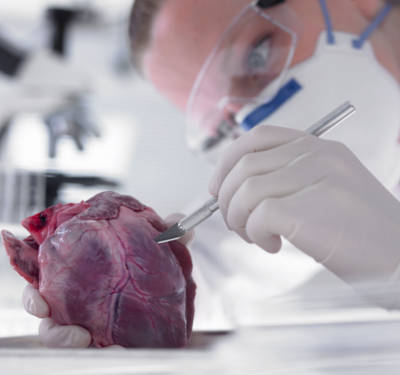Developing our understanding of the heart
The development of new experimental methods to understand the heart drives the search for new treatments.
Published online 31 October 2015

Understanding the heart is driving new treatments.
© OJO Images Ltd / Alamy Stock Photo
A review in the journal Global Cardiology Science and Practice summarizes the experimental approaches that have been developed to investigate the biophysical properties of the heart1.
The heart is a complex organ whose beating is regulated by several fine-tuned regulatory mechanisms, which are inherent to the heart muscle tissue, and which help it to overcome the various stresses that it encounters on a beat-by-beat basis.
One of these mechanisms is the Frank–Starling law, which describes the relationship between the filling of the heart and its output power – the larger the blood volume that fills the heart, the stronger the ejection pressure developed by the ventricle.
Younss Ait Mou of the Qatar Foundation and his colleagues use this as an example to demonstrate how experimental methods development and improvement has enabled to investigate the biophysical properties of the whole heart down to the level of single myocardial fibres.
Laser diffraction methods have enabled investigators to manipulate the length of muscle fibres with great accuracy, while simultaneously measuring other parameters such as tension in heart muscle preparations, and can be combined with methods such as X-ray diffraction to explore the structural arrangement of cardiac multicellular preparations.
Data from these studies can be difficult to interpret, however, and so researchers have developed new experimental strategies to study the function of individual heart muscle fibres.
One approach is to attach them to carbon fibres and measure their electrical and mechanical properties and calcium dynamics at different lengths.
Permeabilized cell preparations, in which the cell membranes are altered to expose the contractile machinery of individual heart muscle fibres, allow researchers to investigate their biophysical properties in even more detail. Advances in these methods now make it far easier to prepare skinned cells, but this method does not allow researchers to accurately study the kinetics of contraction.
To this aim, researchers started investigating the properties of single myofibrils, the smallest contractile element in the heart muscle tissue, by mounting them between two small pipette tips, using one to apply mechanical pressure, and the other to record the forces produced, while exposing them to different conditions. This technoque is more suitable for contraction kinetics assessment.
“These experimental systems have been important for our understanding of the cellular and sub-cellular mechanical properties involved in healthy heart function,” says Ait Mou. “They can help us to understand the mechanisms of heart failure [in order to] develop drug therapies that can specifically target the altered mechanisms.”
Reference
- Ait Mou, Y., Bollensdorff, C., Cazorla, O., Yacoub, M. & de Tombe, P. P. Exploring cardiac biophysical properties. Global Cardiology Science and Practice 2015: 10 | article
DOI: 10.1038/qsh.2015.86

